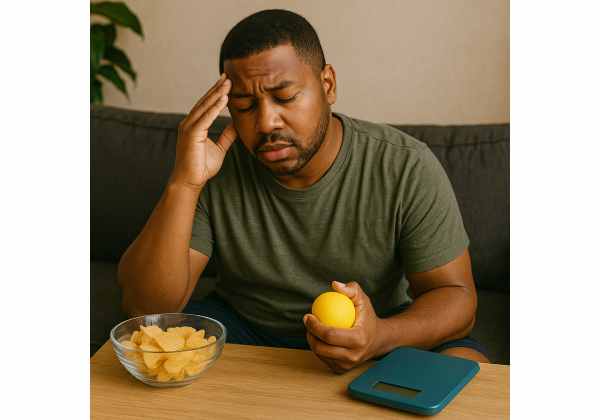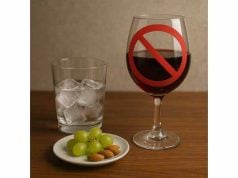
Stress changes appetite, sleep, and decision-making—the exact levers that determine whether a weight loss plan feels doable or fragile. When pressure rises, your brain wants quick relief, not long-term goals. The solution is not more willpower; it is better systems that lower arousal, add friction to impulsive eating, and make the next good choice the easy one. This guide gives you practical tools to calm cravings in ten minutes, build a daily “stress buffer,” and troubleshoot tough weeks. For a concise foundation that connects habits, sleep, and recovery, see our overview of behavior, sleep and stress basics for weight loss.
Table of Contents
- Stress and weight loss basics
- Curb cravings fast: 10-minute plan
- Build your daily stress buffer
- Common mistakes and fixes
- Safety, medications and red flags
- Evidence, metrics and timeline
- Templates you can copy this week
- Frequently asked questions
Stress and weight loss basics
What stress does to eating. When stress rises, the body prioritizes fast energy and short-term safety. Hunger cues shift: you crave quick carbohydrates and fatty, crunchy foods; fullness cues feel muted; and “I deserve this” thinking takes the wheel. If sleep is short, the effect is bigger. You are not broken—this is biology under pressure.
Why it stalls weight loss.
- Impulse over intention: Decision fatigue makes evening choices sloppy.
- Reward learning: If snacks reliably soothe, the brain wires that loop tighter.
- Sleep and hormones: Fragmented sleep increases next-day appetite and reward seeking, pushing calories upward even when meals look reasonable.
- All-or-nothing cycles: Hard restriction after a stressful night often boomerangs into overeating within days.
The leverage points that work.
- Arousal downshift: Breathing, brief movement, and light changes lower stress hormones faster than white-knuckle restraint.
- Friction and defaults: Pre-portion treats, place protein-forward snacks at eye level, and keep “green-light” foods easiest to reach.
- Structure beats willpower: Planned meals and a defined “sweet finish” after dinner end grazing with less effort.
- Sleep protection: An earlier caffeine cutoff and dimmer light at night reduce cravings tomorrow.
A simple operating system:
- Steady meals, especially protein earlier in the day.
- Ten-minute stress reset you can use mid-afternoon and after work.
- Environment design that nudges you toward balanced food and away from trigger foods when tired.
- One progress metric (weekly weight trend or “green meals” per day) so wins remain visible during stressful weeks.
Where this fits in your broader plan. Stress management is not a side quest; it is the scaffolding that keeps nutrition and movement consistent. For pacing, targets, and safe rates of change, skim our core weight loss guide and layer the stress tools below on top.
Bottom line: You do not need a calmer life to make progress. You need calming practices and guardrails that hold under life as it is.
Curb cravings fast: 10-minute plan
Use this on any day when urges spike. It is short, portable, and designed for busy people. The order matters: downshift → decide →, if needed, eat on purpose.
Minute 0–2: Drop arousal.
- Exhale longer than you inhale (four seconds in, six out) for ten breaths.
- Unclench jaw and hands. Roll shoulders; look at a distant point for 20 seconds to relax near-focus tension.
- If indoors, step outside or face a window—a light change signals “state shift.”
Minute 2–5: Move briefly.
- Walk a flight of stairs or a brisk hallway loop.
- If stuck at a desk: 10 slow air squats, 10 wall push-ups, 30-second march in place.
Brief movement burns off some stress energy and increases a sense of control.
Minute 5–7: Clarify the urge.
- Ask: Am I hungry, or do I need relief?
- Apple test: Would a yogurt bowl or apple with peanut butter do the job? If yes, you are hungry. If no, it is likely a craving for a specific taste or comfort.
Minute 7–10: Choose with structure.
- If hungry: Eat a structured snack (protein + fiber + modest carbs): Greek yogurt with berries; cottage cheese and pineapple; edamame and fruit; toast with peanut butter.
- If craving relief: Choose a non-food soother for ten minutes: a short walk outside, stretch with music, hot shower, or message a friend. Set a timer. Reassess after.
Boundaries that help immediately
- Pre-decide nights: “After dinner I have a planned sweet finish, then tea.” This shuts the door on grazing.
- Single-serve your treats. The package is not the portion.
- Brush teeth after the sweet finish to send a “kitchen closed” signal.
For grab-and-go food ideas that satisfy without triggering more snacking, bookmark our quick protein and fiber toolkit and keep two options in your bag or desk.
Key idea: A craving is a wave. Ride it for ten minutes, and it usually breaks. If you truly need food, a structured snack ends the episode cleanly.
Build your daily stress buffer
You cannot control every stressor, but you can raise your stress capacity. Think of a “buffer” as small, repeatable actions that keep your baseline low so spikes do not tip you into overeating.
Morning anchors (set the tone).
- Light within an hour of waking. Step outside or sit by a bright window for a few minutes.
- Protein at the first meal (25–35 g). This reduces later snackiness and helps you feel grounded.
- Move early, even briefly. A ten-minute walk or mobility flow stabilizes mood and energy.
Workday rhythm (protect focus and appetite).
- Meal spacing: Aim for three meals and one planned snack or four smaller meals 3–4 hours apart. Long gaps breed “I deserve this” evenings.
- Hydration cadence: Glass on waking, mid-morning, lunch, mid-afternoon, dinner. Dehydration often wears a snack costume.
- Caffeine timing: Enjoy it early; set a cutoff 8–10 hours before bedtime.
Evening design (close loops, then land the plane).
- Shutdown ritual (5 minutes): Write tomorrow’s top task, tidy one surface, power down notifications.
- Balanced dinner (protein + veg + starch) followed by a planned sweet finish (e.g., Greek yogurt and berries).
- Lights downshift the last hour: dim lamps or use a warm light; phone charges out of reach.
Movement as a stress valve.
- Tie 10-minute walks to meals—after lunch or dinner—rather than waiting for motivation. Small, certain beats big, unlikely. For specifics, steal our step-by-step on post-meal walks.
Environment that chooses for you.
- Put treats in opaque bins; place protein-forward snacks at eye level.
- Pre-portion snacks; do not rely on “I’ll stop at a handful.”
- Keep a “stress kit” where you feel most vulnerable (tea bags, resistance band, journal, earphones with a calming playlist).
Accountability without pressure.
- Weekly check-in: What helped? What got in the way? What is the smallest change that would fix that?
- Pair up for micro-habits—two texts per week with a colleague or friend: “post-dinner walk done” or “caffeine cutoff hit.”
Bottom line: A buffer is not a spa day. It is simple, repeatable scaffolding that keeps your appetite and mood steady through daily stress.
Common mistakes and fixes
Saving up calories for night
Arriving at the couch hungry guarantees overeating. Fix: Eat a full dinner (protein + veg + starch) and end with a planned sweet finish. If evenings are still loud, add a protein-forward afternoon snack.
Relying on willpower at 9 p.m.
Decision fatigue is real. Fix: Use friction (opaque containers, single-serves) and default routines (tea, 20-minute timer, hands-busy TV). Design beats discipline.
Using food as the only stress valve
Food works quickly, so the brain keeps choosing it. Fix: Build a menu of non-food soothers: brisk walk, shower, stretch routine, two-line journal dump, breathing practice. Practice them on good days so they are available on hard days.
Under-protein mornings
A pastry at 8 a.m. becomes a pantry raid at 9 p.m. Fix: Start with 25–35 g protein (eggs, yogurt, cottage cheese, tofu scramble) and include fiber.
Late caffeine and alcohol
Both fragment sleep and amplify next-day cravings. Fix: Set a caffeine cutoff 8–10 hours before bedtime. Keep alcohol earlier and modest.
Trigger foods in plain sight
Your environment is stronger than your intentions after a long day. Fix: Do a 20-minute kitchen reset with our pantry and snack swaps. Put “green-light” foods front and center.
Trying to overhaul everything
Massive changes burn you out. Fix: Choose three anchors for the next seven days: protein at the first meal, a post-dinner walk, and a planned sweet finish. Reassess weekly.
No plan for work stress
Unplanned afternoons lead to vending-machine dinners. Fix: Keep a desk stash (protein bar with fiber, nuts in single packs, tuna packet, fruit) and a written 10-minute reset you can do between meetings.
Remember: Mistakes are information. Adjust one lever at a time and watch evenings calm down.
Safety, medications and red flags
Stress eating often overlaps with medical or psychological factors. Addressing them early makes progress faster and safer.
Sleep apnea
Snoring, gasping, or unrefreshing sleep despite adequate hours increases evening cravings. Action: Ask about testing if these signs fit. For plain-language steps, see our guide to sleep apnea and weight loss.
Diabetes or reactive hypoglycemia
Night-time lows can feel like urgent sugar cravings. Action: Follow your care plan, monitor as advised, and prefer balanced snacks (protein + modest carbs). Frequent lows at night warrant a discussion about medication timing or doses.
ADHD, SSRIs, antipsychotics, steroids
These can affect appetite and sleep. Action: Ask your clinician about dosing time shifts and supportive nutrition strategies (earlier protein, controlled portions of trigger foods).
High stress, low mood, or anxiety
Persistent distress, loss of interest, or sleep disruption deserves attention. Action: Consider counseling; specific therapies (like CBT or ACT) help with stress eating and mood.
GI reflux
Rich desserts near bed can worsen reflux and disturb sleep. Action: Leave a 2–3 hour buffer after larger meals; keep late snacks small and balanced.
When to seek help now
- You feel sleepy while driving or have near-misses.
- You wake repeatedly to eat and feel out of control.
- Rapid weight changes, dizziness, shaking, or night sweats accompany cravings.
- New chest pain or severe breathlessness.
Social and support angle
Stress is lighter when shared. Invite one person into your plan and ask them to check in weekly. If you prefer structured accountability, a coach or group can provide external scaffolding while you build internal habits. For self-guided structure, our resource on identifying emotional triggers can help you map patterns without judgment.
Evidence, metrics and timeline
What the science consistently shows: Short or poor-quality sleep and acute stress increase appetite for calorie-dense foods, reduce spontaneous movement, and worsen insulin sensitivity. Lowering stress and improving sleep does not replace nutrition or activity, but it amplifies both—making consistent choices easier.
A realistic results arc (8–12 weeks)
- Weeks 1–2: Evenings feel calmer with a planned sweet finish and the 10-minute reset. Afternoon energy steadies.
- Weeks 3–6: Snack frequency drops; you feel “done” after dinner most nights. Training or walks feel easier to start.
- Weeks 7–12: Weight trend becomes clearer if meals are structured and movement is routine. Cravings become less intense and less frequent.
Measure the right things.
- Process metrics (daily): hit caffeine cutoff, ran the 10-minute reset, post-dinner walk done, used planned sweet finish.
- Outcome metrics (weekly): average weight trend, waist measurement every two weeks, evenings without unplanned snacks.
How to weigh without obsession.
- Weigh three mornings per week under similar conditions; average them.
- Expect normal swings from salt, travel, or menstrual cycles. Trend > single days.
Adjust in order when progress stalls.
- Sleep average ≥7 hours?
- Protein at the first meal daily?
- Caffeine cutoff respected?
- Environment supporting you (pre-portioned treats, green-light snacks visible)?
Once those are steady, refine nutrition using our approach to tracking without strict calories or trend-based weigh-ins if you prefer numbers-light structure.
Bottom line: Stress tools create the conditions where small nutrition and movement changes finally show up.
Templates you can copy this week
Use these as plug-and-play starting points. Adjust 30–60 minutes to fit your life. Keep the structure; move the clock as needed.
Weeknight at home (TV night)
- 6:30 p.m. Dinner (plate method: protein + veg + starch).
- 7:00 p.m. Planned sweet finish; kitchen reset; teeth brushed.
- 7:10 p.m. 10-minute reset (tea + light stretch + breathing).
- 7:25 p.m. TV with a hands-busy activity (fold laundry, foam roll).
- 9:30 p.m. Lights dim; wind-down; bedtime routine.
After a stressful workday
- Commute: Two songs of box breathing or a short walk before entering home.
- Home: Quick protein-forward mini-meal if ravenous (eggs on toast, yogurt bowl).
- Then: 10-minute reset; plan tomorrow’s top task; shower; herbal tea.
Parents with evening chaos
- Before pickup: Protein-and-fiber snack to avoid cooking while starving.
- Dinner: One-pan protein + veg + quick starch (e.g., sheet-pan chicken, microwave rice).
- Post-dinner: Family walk or kitchen dance break; planned sweet finish after dishes.
Work-from-home crunch days
- Noon: 10-minute walk outside.
- 3:30 p.m.: Protein-forward snack; caffeine cutoff respected.
- 5:30 p.m.: Shutdown ritual (top task written, desk cleared).
- Evening: Planned sweet finish; 20-minute timer; phone charges away from the couch.
Night-shift variant
- Before shift: Main balanced meal.
- Mid-shift: Protein-and-fiber snack; brief bright-light exposure.
- End of shift: Small pre-sleep snack; blackout room; device on do-not-disturb.
- Wake period: 10-minute walk early; caffeine cutoff 8–10 hours before sleep.
Three-anchor “tough week” plan
- Protein at the first meal.
- Post-dinner 10-minute walk.
- Planned sweet finish and teeth brushed.
Scripts to say out loud
- “Kitchen is closed; tea is on.”
- “If I truly want food, I will have yogurt and berries.”
- “Ten minutes first; then I will decide.”
Run one template for seven days, then adjust one element. Momentum beats perfection.
Frequently asked questions
Does stress actually prevent weight loss?
Chronic stress does not block fat loss outright, but it raises cravings, reduces sleep quality, and pushes you toward calorie-dense foods. That combination makes a consistent calorie deficit harder to maintain. Lower arousal, protect sleep, and structure evening routines to make steady progress possible.
How can I stop stress eating at night?
Use a planned sweet finish after dinner, then run a 10-minute reset: slow breathing, brief movement, tea, and a 20-minute timer. If hunger remains, choose a protein-forward snack. Dim lights and set your caffeine cutoff earlier to reduce tomorrow’s urges.
Do I need to test cortisol to lose weight?
Routine cortisol testing is not necessary for most people. Focus first on controllable levers: sleep average ≥7 hours, earlier caffeine cutoff, protein at the first meal, brief daily walks, and environment design. Discuss testing with your clinician only if symptoms suggest a medical issue.
What quick tools reduce stress before meals?
Try four slow breaths (4 seconds in, 6 seconds out), a 2–5 minute walk or stretch, and a glass of water before eating. These downshift arousal, increase awareness, and improve portion control without adding time or complexity to your day.
What if cravings hit at work?
Keep a desk stash: a protein bar with fiber, single-serve nuts, tuna packets, and fruit. Step away for two minutes, breathe slowly, and decide: structured snack or non-food soother. Pre-decide vending-machine rules (e.g., only once per week, single item).
How long until stress eating improves?
Many notice calmer evenings within one to two weeks of using a planned sweet finish, 10-minute resets, and a caffeine cutoff. Over 4–8 weeks, cravings become less frequent and less intense, especially when sleep and protein intake are consistent.
References
- Effects of Experimental Sleep Restriction on Energy Intake, Energy Expenditure, and Visceral Obesity — 2022 (RCT)
- After Dinner Rest a While, After Supper Walk a Mile? A Systematic Review with Meta-analysis on the Acute Postprandial Glycemic Response to Exercise Before and After Meal Ingestion in Healthy Subjects and Patients with Impaired Glucose Tolerance — 2023 (Systematic Review & Meta-analysis)
- Dose and timing effects of caffeine on subsequent sleep: a randomized clinical crossover trial — 2024 (RCT)
- Breathing Practices for Stress and Anxiety Reduction — 2023 (Systematic Review)
- Stress and eating behaviours in healthy adults: a systematic review and meta-analysis — 2022 (Systematic Review & Meta-analysis)
Disclaimer
This article provides general education and is not a substitute for personalized medical advice, diagnosis, or treatment. Stress-related eating can overlap with medical conditions, medications, sleep disorders, and mood concerns. Talk with your clinician or a registered dietitian for guidance tailored to your health history, prescriptions, and goals.
If this guide helped, consider sharing it with someone who struggles with evening cravings, and follow us on Facebook, X, or whichever network you prefer for practical tools on stress, sleep, and nutrition that make weight loss sustainable.










